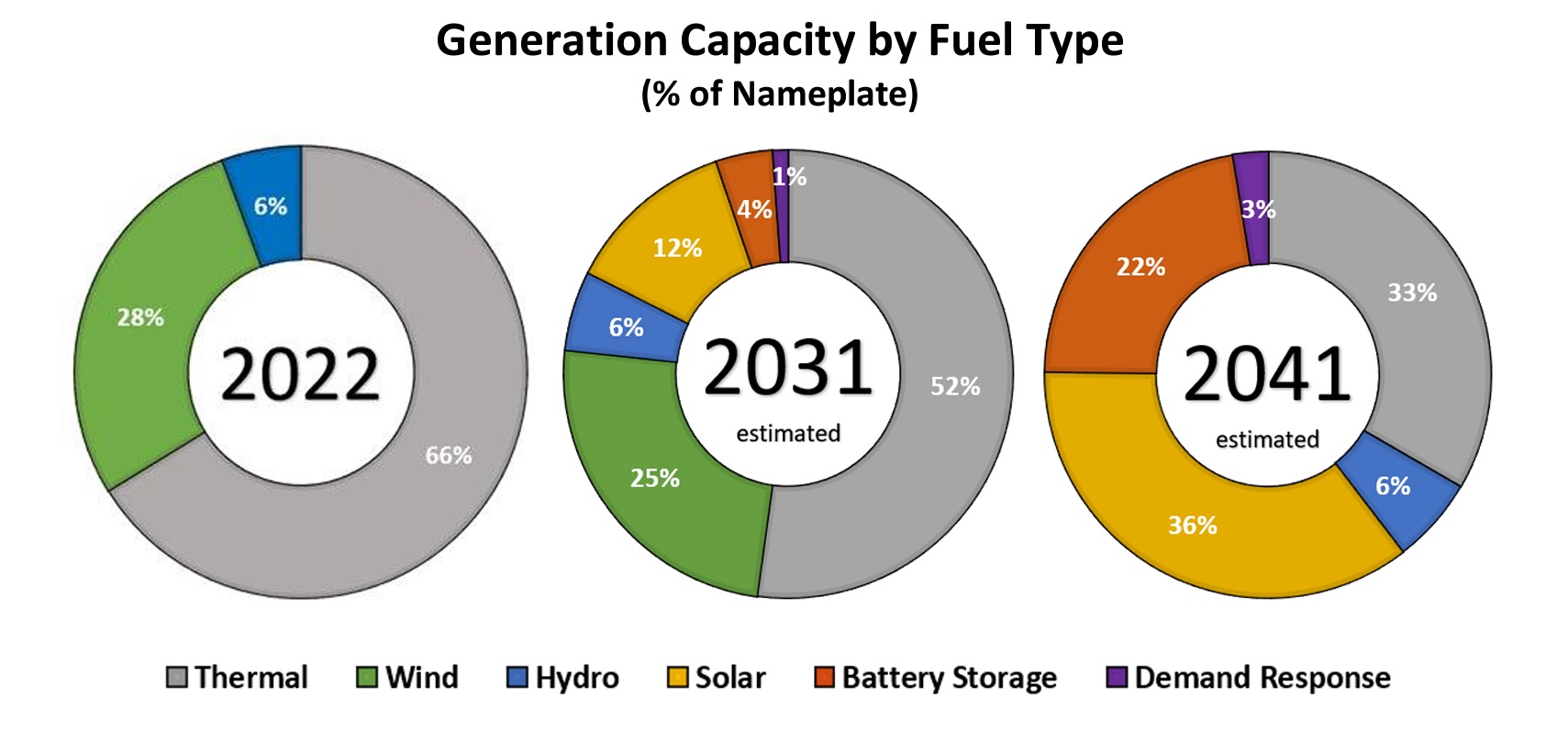About 66 percent of the Springfield City Utilities’ power generation capacity is fueled with coal and natural gas. By 2041, the plan is to drop that percentage to 33 percent.
As the Beatles once sang, “Here comes the sun.”
Solar power — both purchased from other places and made in Missouri — is a key part of City Utilities’ integrated resource plan (IRP), a guiding document that will shape power generation, transmission and distribution from now to 2041.
Leaders from Springfield City Utilities unveiled a late draft of the plan in December, and a public comment period is open until about Jan. 12, 2023. The plan includes a forecast of how much electricity Springfield will use each year, how energy trends will change, and how City Utilities will meet the demand so that when you flip the switch, the lights come on as expected.
City Utilities President Gary Gibson explained economics, federal regulations, membership in the Southwest Power Pool and the expectations of everyday Springfieldians are all part of the plan.
“We have to keep all of those things in mind as we try to balance that three-legged stool of sustainability, reliability and affordability,” Gibson said. “Future planning is so important.”
Net zero? More like net reduction

City Utilities aims to reduce carbon dioxide emissions from its 2005 level by 70 percent by 2035. In 2020, the reduction was at 48 percent. The longer goal is to reach net zero carbon emissions by 2070.
City Utilities Chief Electric Operations Officer Chris Jones explained that all of the numbers projected in the report are estimates, and that the plan is updated every three to five years because the data changes frequently.
“The base case is really the most likely case we think at that point in time that will occur in the future over 20 years,” Jones said. “It’s a guess, but it’s an educated guess.”
The forecast for power demand in Springfield is based on peak demand and energy consumption data from the past 10 years. The demand for electricity in Springfield will grow over the next 20 years, but the growing demand is expected to be slow.
“With the continued economic development that we have in Southwest Missouri, especially within our service territory in Springfield, also with (electric vehicle) potential, we see our load growing over time,” Jones said. “Our load has actually been really flat due to energy efficiency over the last several years, in general.”
The demand load for power is expected to grow yearly by 0.45 percent from now until 2041.
“This increase is due to population growth, increased electrification of homes and businesses, and increasing amounts of electric vehicles,” part of the plan related to growth reads.
The Southwest Power Pool raised the winter power reserve requirement for Springfield City Utilities from 60 megawatts to 143 megawatts. This was in response to Winter Storm Uri, and the outages that affected the Southwest Power Pool and other utility territories in the United States.
“Summertime used to be the biggest concern,” Jones said. “(Uri) occurred in the winter, so now there’s a big emphasis on the wintertime.”
Local sourcing and energy buying

City Utilities buys thermal and renewable energy from 15 different sources, adding to 1,222 megawatts of capacity. It also generates up to 818 megawatts at its three generating sites, namely the John Twitty Energy Center in Springfield. JTEC is a coal-fired power plant.
CU buys a mix of power made from landfill gas, solar farms, hydroelectric dams and wind farms, with 345 megawatts of capacity coming from wind power.
Future calls to action are broken up in five-year increments in the planning document. In the first five years, from 2022 to 2027, City Utilities would do a feasibility study on available land to build solar farms. Long-term solar power purchases require years of lead time.
According to the plan, one of the two coal generation units at the John Twitty Energy Center would be retired April 1, 2030. That’s a delay from 2027, which means three more years for the coal-fired unit that were not in the previous plan from 2019.
“There are a number of reasons why we’ve made that decision,” Jones said. “Some of them are related to the Winter Storm Uri events, some of them are related to some uncertainty with (Southwest Power Pool) in terms of their interconnection backlog, and also some supply chain issues with solar, which is the most significant replacement resource for that unit.”
Sierra Club Missouri Conservation Program Coordinator Marisa Frazier voiced objections to the delayed retirement of the coal-fired generation unit.
“City Utilities should not delay the retirement of Twitty coal unit No. 1,” Frazier said. “Prematurely deciding to delay retirement could force ratepayers to pay for an expensive legacy coal unit when alternatives are available.”
The plan does not recommend any new sources of thermal power, which means CU will continue to phase out coal-fired power and replace it with solar power with battery backing.
“It appears it’s going to be in our best interest to own solar, which is different for us,” Jones said.
Decades beyond

By 2030, CU is also expected to be buying 150 megawatts from a locally-sourced solar farm, and have 30 megawatts of battery storage available. There is also a call to convert two natural gas generation units at the James River Power Station site into “dual fuel” generators by making modifications that would allow the generators to run on diesel fuel.
In 2033, a pair of natural gas generators at the John Twitty Energy Center will be retired and their capacity will be replaced by 200 megawatts of solar generation, and that could come from non-local sources. However, City Utilities doesn’t want to buy too much power from other sites in the Southwest Power Pool, and that’s because of its relatively high cost.
“If you looked at the average price of energy across the SPP footprint, we’re paying a premium,” Jones said.
There are two actions City Utilities can take to lower the overall cost of power over time, Jones said. The first is to relieve “congestion” by improving power transmission infrastructure across Springfield. The second is for CU to produce more of its own electricity.
“It makes local generation more valuable; it acts as a price hedge if we can have local generation,” Jones said.
To that end, City Utilities has a local generation minimum included in its comprehensive plan.
“We talked about it as a team that we want to maintain at least 50 percent local generation,” Jones said. “There are conversations that it should maybe be more than 50 percent.”
More natural gas generator retirement is slated for 2038, when the turbines at the James River Power Station will be retired. CU plans to acquire 170 megawatts of battery storage at the same time.
Calls to seek federal aid
Louise Wienckowski, chair of the White River Group of the Sierra Club, said City Utilities should be more aggressive when it comes to eliminating coal generation.
“Greene County experienced record-breaking heat in June and July, as well as severe drought throughout the summer and early fall — all consequences of climate change,” Wienckowski said. “Utility companies are in a key position to reduce those emissions by transitioning to renewables sooner rather than later.”
Wienckowski said the world is teetering on the edge of irreversible climate change, and called on City Utilities to lead moves toward fighting climate change. The Sierra Club implored CU to seek funding through the U.S. Inflation Reduction Act, which includes clean energy incentives in the form of tax credits and loans. Wienckowski called the incentives in the legislation “a once in a generation opportunity.”
According to the U.S. Department of Energy, the Inflation Reduction Act includes $86.6 billion to carry out up to $350 billion in loans, “to help retool, repower, repurpose, or replace energy infrastructure that has ceased operations or to improve the efficiency of infrastructure that is currently operating.”

